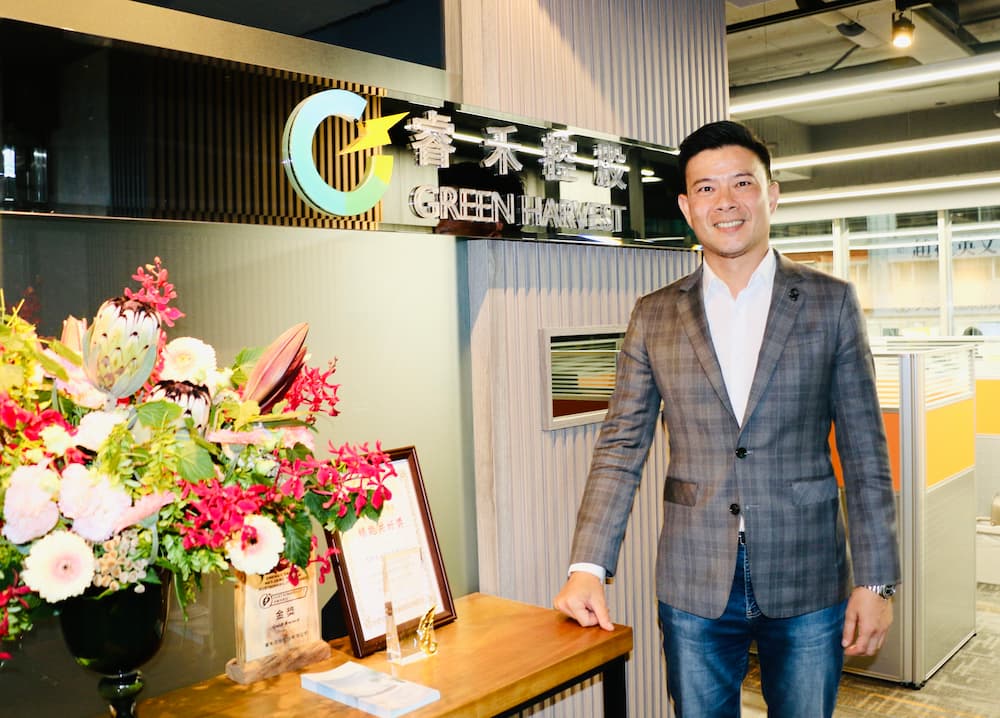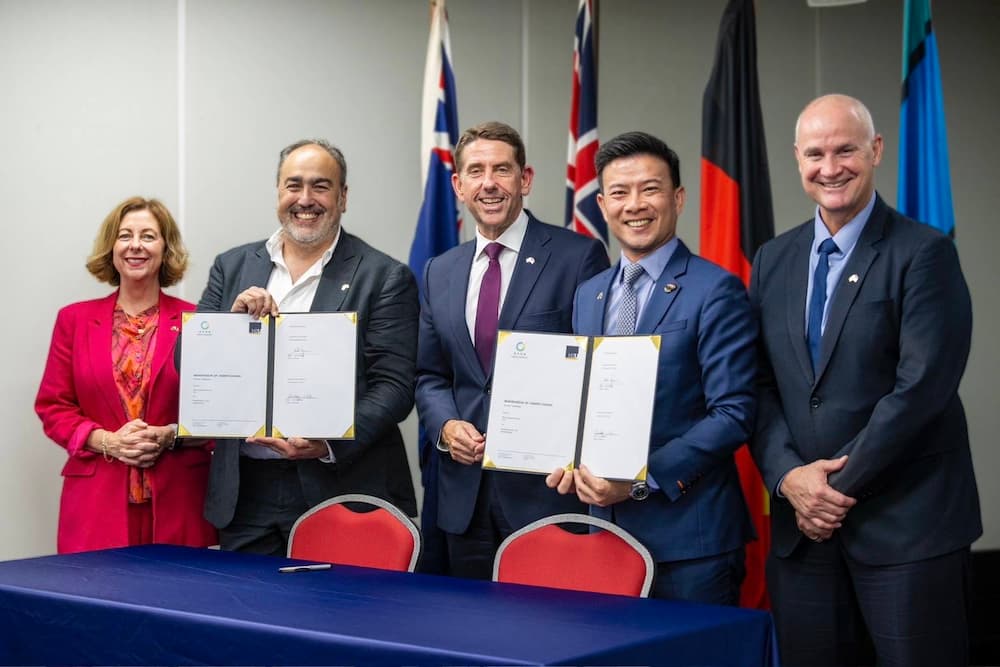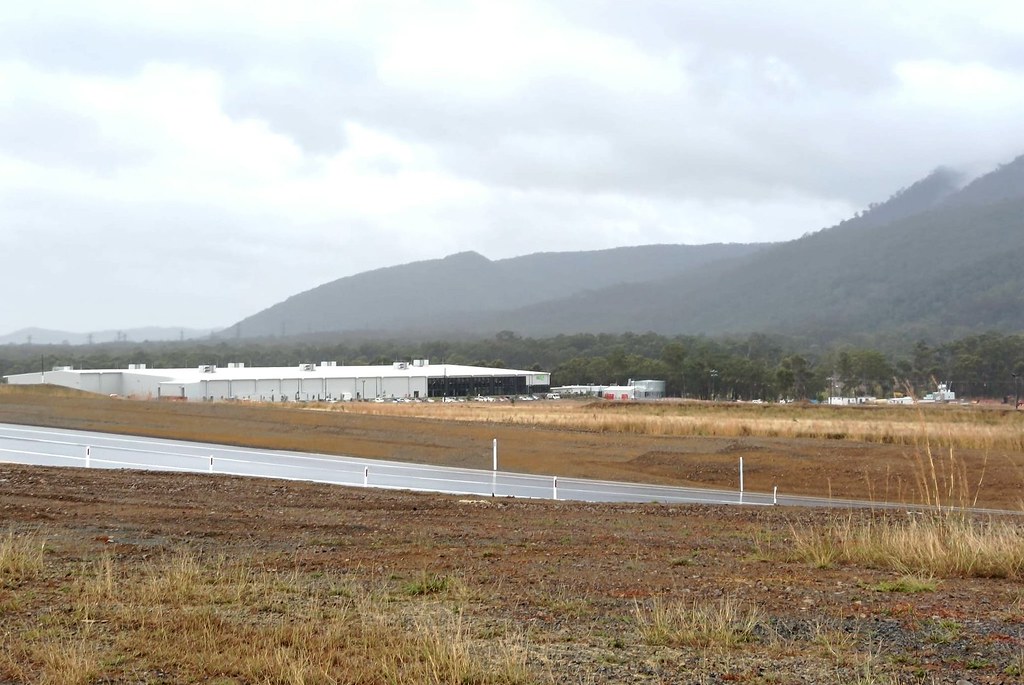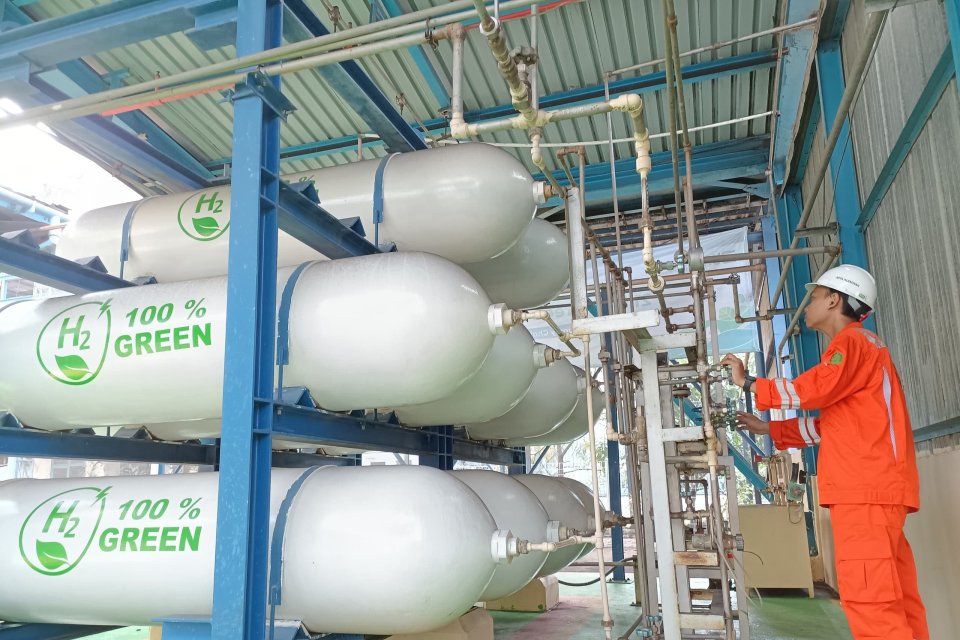Green Harvest, a Taiwanese energy integration company, has recently signed Hydrogen Utility (H2U), the first green hydrogen development agreement with Australia.
Under the agreement, Australia is expected to begin transporting green ammonia to Taiwan in 2028.
Why did Green Harvest choose to cooperate with Australia to take an early lead in the hydrogen energy market? What opportunities do they see?

Green Harvest's Chairman Chen Kun-hong talks about the strengths of green hydrogen production in Australia and hopes more Taiwanese companies will invest in the industry. (Photo: Hsu Tsu-lin)
After a year of evaluation in both Taiwan and Australia, Green Harvest announced on May 2 that it has become the exclusive partner of the cross-border green hydrogen project H2U in Taiwan.
Green Harvest's Chairman Chen Kun-hong (陳坤宏) said that the company’s introduction of green hydrogen was motivated by its involvement in Shalun Smart Green Energy Science City (SSGESC), a BOT project in Tainan, in 2022, when the company founded Smart Harvest, a franchise company with Acer.
Smart Harvest focuses on the installation of solar power generation and energy storage facilities, a smart grid, and the establishment of an energy management integration center at SSGESC, with the goal of achieving 100% renewable energy penetration during peak hours in the park.
According to Chen, 80% renewable energy penetration can be easily achieved with Taiwan's existing solar and wind resources, but to reach 100%, it must rely on energy storage or the use of green hydrogen and green ammonia.
When the company's research team had the opportunity to participate in a meeting between Taiwan's Energy Administration and the investment arm of the Australian state of Queensland, they noticed Australia's strengths in green hydrogen production.
With a land area 130 times larger than that of Taiwan, sparsely populated and inexpensive land, as well as abundant sunshine, Australia has the lowest cost of solar power in the world, with green electricity costing less than TWD 1 per kWh, one-fifth of Taiwan's feed-in tariff (FIT).
Typically, electrolyzing one kilogram of water consumes 55 kWh of electricity. In Taiwan, it costs TWD 275 to produce hydrogen from one kilogram of water, while in Australia it costs only TWD 55.
"This is unimaginable for Taiwanese companies under the FIT system," Chen said, adding that it was the cost advantage that led Green Harvest to collaborate with Australia to develop the green hydrogen industry, paving a new path for Taiwan's energy transition.

Green Harvest signs H2U with Australia. (Photo: Green Harvest)
Catching up with the world
According to the H2U, an annual green ammonia production capacity of 4 million tonnes is expected by 2032, with a portion of the green hydrogen and green ammonia produced supplying locally in Australia and the rest exporting. As the transport of liquid hydrogen is still in the experimental phase, the green hydrogen will need to be converted to green ammonia before it can be exported to Taiwan, Japan, and South Korea.
The first phase of the project is expected to be completed by 2028, with an annual production capacity of 1 million tonnes.
Green Harvest struggled to broker Taiwan's first green hydrogen development agreement with Australia, as many projects had already been claimed by Japan, South Korea, the U.S., and Germany.
The Japanese and Korean governments have been promoting programs to import green hydrogen from overseas due to dense populations and limited land, but Taiwan, facing similar constraints, has yet to follow suit, Chen said.
Without hydrogen-related legislation in Taiwan, green hydrogen developers have little knowledge about the government's and industry's demand. "In the initial discussions, we often had to spend extra time explaining that Taiwan is a highly energy-intensive country and requesting them to allow Taiwanese companies to participate," Chen said.
Chen believes that the reason it took so long for Taiwanese companies to open up overseas green hydrogen cooperation is that Taiwan's industry focused on manufacturing and lacks experience in seeking overseas cooperation opportunities from the upstream. Therefore, Green Harvest hopes to attract more companies to participate in green hydrogen development by facilitating the H2U project.

Queensland is home to several large-scale hydrogen projects. Pictured is Gladstone, the intended site of the H2U project. (Photo: Green Harvest)
Chen is optimistic about green hydrogen development, believing it will become Taiwan's next trillion-dollar industry and drive overall industrial upgrading. The potential impact of green hydrogen and green ammonia is very extensive, as the introduction of this energy source will require modifications to pipelines and internal combustion engines, as well as affecting agricultural fertilizer systems.
In the transportation sector, trucks, ships, and airplanes may also shift to green hydrogen fuel, all of which will require significant research and development resources, he said.
Taiwanese companies are starting to develop hydrogen technology. This year, Delta announced a partnership with a subsidiary of Ceres Power Holdings, a UK-listed hydrogen company, to develop a complete solid oxide hydrogen fuel cell system leveraging Delta's manufacturing strengths in power electronics, controls, and thermal management, according to Chen.
Taiwan-made motors, electrolyzers, and water treatment technologies for the semiconductor industry all have the potential to enter the hydrogen energy industrial chain.
Reducing energy consumption and policy incentives are key
In addition to finding low-cost overseas resources, how else can Taiwanese companies reduce the cost of developing green hydrogen energy? Referring to the path taken by the Australian government and private sector, Chen proposed two solutions.
The first is to reduce the power consumption of water electrolysis. He cited the hydrogen electrolyzer developed by Australian startup Hysata as an example, which, through material science and catalytic conversion, has achieved the world's highest electrolysis efficiency of 95%, equivalent to 41.5 kWh per kilogram of water, much lower than the general hydrogen electrolyzer's power consumption of 55 kWh per kilogram.
The second is to call for the government to increase investment and introduce subsidy policies to support and promote the green hydrogen industry. For example, Australia proposed the Capacity Investment Scheme (CIS) after COP28, aiming to make Australia a leader in hydrogen production and export, which is expected to bring in tens of billions of Australian dollars in investment.
Other leading regions include the EU, which established the European Hydrogen Bank (EHB) in 2023 to promote investment in green hydrogen production. At the end of the same year, the U.S. proposed Clean Hydrogen Production Credit regulations under the Inflation Reduction Act (IRA). The industry is watching closely to see if the Taiwanese government can stimulate the hydrogen industry through interest rate cuts, financing optimization, and financial engineering.
Australia, Taiwan's largest energy trading partner, supplies about two-thirds of the country's coal and one-third of its natural gas. Recognizing that the era of fossil fuels is coming to an end, Australia finds it necessary to invest in research and development of green energy technologies.
Chen believes that while Australia is actively developing renewable energy, Taiwan should also seek opportunities for cooperation between the two sides during the net-zero transition. “Instead of just waiting for green hydrogen imports, Taiwan should create overseas GDP, which is the next step in our endeavor,” he said.
Taiwan shall seek cooperation with Southeast Asia to maintain its green competitiveness
Southeast Asian countries have also been actively promoting green hydrogen in recent years. Indonesia aims to become a green hydrogen exporter by 2030, while Thailand and Malaysia have signed green hydrogen development cooperation agreements with overseas companies. The competitive and cooperative relationship between Taiwan and Southeast Asian countries is worth paying attention to in the next decade, said Chen.
“We must look at Southeast Asia very carefully as a competitor,” Chen emphasized, noting that Southeast Asian countries have abundant natural resources, low labor costs, and offer a variety of renewable energy testing grounds. If the Taiwanese government lags behind in promoting RE100, upstream manufacturing could be relocated to countries with lower electricity carbon intensity and a higher share of green energy use.
However, Chen also sees opportunities in this situation. Just as Green Harvest cooperated with Australia due to the high cost of green hydrogen in Taiwan, Taiwan can invest in Southeast Asian countries to expand its available resources. “If we can't win the competition, then we should become their partner,” he said.

Indonesia eyes the potential of green hydrogen and aims to become an exporter of green or low-carbon hydrogen as early as 2030. (Photo: PLN)